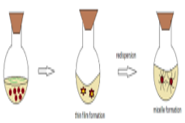Abstract
Targeting of the drug directly to the cells, tissues, or organs with no impact on healthy cells is a challenge. In the current era, it’s been made pos- sible by therapeutic interventions. The novel drug delivery systems such as nano particulates, liposomes, aquasomes, phytosomes, dendrimers, nano sponges, nano micelles are developed. Nano micelles are developed for effi- cient targeting and are currently in trend as therapeutic carriers of water- insoluble drugs. Micelles are self-assembling Nano-sized colloidal particles with a hydrophobic core and hydrophilic shell. Among the micelle-forming compounds, amphiphilic copolymers, i.e., polymers consisting of hydropho- bic block and hydrophilic block, are gaining increasing attention. Polymeric micelles possess high stability both in vitro and in vivo with good biocompat- ibility. Nano micelles are used widely because of the smaller size range of 10 to 100nm, with greater drug loading capacity. Advantages over other dosage forms include solubilization of poorly soluble drugs, sustained release, pro- tection of drugs from degradation and metabolism. The property discussed includes CMC, size, and aggregation number, and stability. CMC is the min- imum polymer concentration required for micelle formation. Aggregation number (Nmicelles, and it ranges between tens to hundreds. Thermodynamic stability is based on size, the optical clarity of solution, viscosity, and surface tension. Kinetic stability accounts for micellar integrity. This review will discuss some recent trends in using micelles as pharmaceutical carriers such as to deliver drugs in conditions such as TB, cancer, ocular complications, etc.
Full text article
Authors

This work is licensed under a Creative Commons Attribution-NonCommercial-NoDerivatives 4.0 International License.

